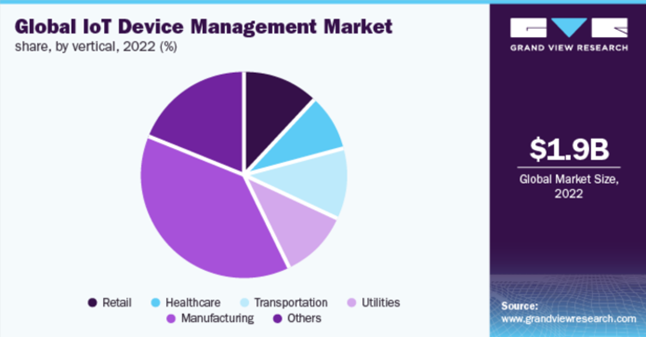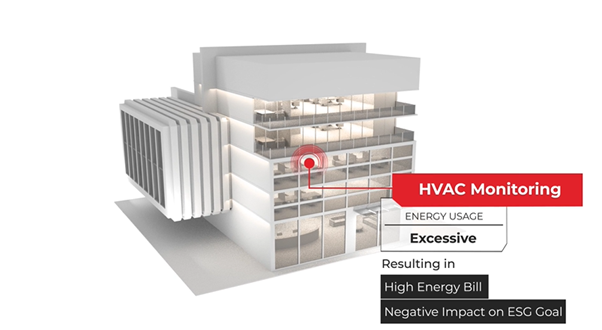
The Internet of Things (IoT) is the interconnectivity of physical apparatuses, vehicles, people, and various objects that are embedded with sensors, software, and network interconnectivity, enabling them to gather and exchange data. In today’s world, where access to data is table stakes, there are still many processes, machines, and other technologies that have yet to be fully connected and considered what the industry deems as smart. This digital transformation is just getting started.
According to Grand View Research, the global IoT device management market size was valued at USD 1.88 billion in 2022 and is expected to register a compound annual growth rate (CAGR) of 34.9 percent from 2023 to 2030. The growing focus of enterprises on controlling linked devices and improving operational efficiencies across industry verticals is expected to boost the demand for IoT device management.

The constant expansion of IoT is a clear indication that it is here to stay and will continue to play a crucial role in shaping the future. Despite some processes, machines, and other entities not yet being connected, it is only a matter of time before they will need to be integrated into this technology-driven world. The future is undeniably linked to IoT, and its growth is a testament to this fact.
“The constant expansion of IoT is a clear indication that it is here to stay and will continue to play a crucial role in shaping the future.”
-IoT.nxt
A Faster, More Un(predictable) World
The continual progression of technology is compelling businesses to embrace IoT. It has transcended the mere desire for efficiency and has become a necessity. In today’s rapidly advancing landscape, failing to maintain efficiency results in obsolescence and irrelevance.
An excellent example is ChatGPT’s technology. For the first time, Google has run into difficulty, as they overlooked the fact that technology must continuously evolve to keep pace with the dynamic environment.
IoT has emerged as a game-changing technology that provides more predictability in an unpredictable world. IoT enables the collection and analysis of real time data from connected devices, which can be used to predict and prevent potential issues before they occur.
IoT Driving Transformation
Digital transformation involves the integration of digital technologies into all areas of a business, resulting in fundamental changes to how the business operates and delivers value to customers. The current state of IoT, with its rapidly evolving technology and the increasing adoption of interconnected devices, is optimally positioned to drive digital transformation across various industries.
By enabling businesses to collect and analyze vast amounts of data in real-time, IoT facilitates the optimization of business processes, the creation of new revenue streams, and the development of innovative business models.
The integration of IoT devices into business operations offers the potential for businesses to gain insights into customer behavior, improve operational efficiency, and enhance overall customer experience. Therefore, it is expected that the continual advancement and expansion of IoT will increasingly drive digital transformation across industries.
IoT is Adding Relevance to Technology Advancements
IoT has made predicting the future a less intimidating prospect. The technology has successfully bridged the gap between the digital and physical world, providing a future-proof environment that can evolve with technological advancements, instead of being left behind. It can collect and analyze massive amounts of data from interconnected devices to provide us with meaningful insights into various aspects of our lives and businesses.

The growth of the Internet of Things has been accompanied by various challenges, yet it has persevered and reached its current state. From compatibility issues to data security and scalability. These are just a few of the teething issues that businesses faced when implementing IoT technology.
Early adopters played a crucial role in resolving issues through testing and establishing the technology. As a result, businesses can now benefit from the faster and more dependable implementation of IoT solutions, allowing for smoother integration into their operations.
Effortless Interoperability: The Key to Seamless Technology
The complexity of IoT can be overwhelming for many, causing confusion and uncertainty. As more and more devices are added to an IoT network, managing and scaling the infrastructure can become a challenge. The sheer number of devices and the amount of data they generate can quickly overwhelm existing systems, making it difficult to manage and analyze data effectively.
Business owners are often unsure about the need to upgrade their equipment and the various technology stacks involved in IoT. It’s time to shift the focus from a complex technology stack to a simple solution.
Outdated technology and processes should no longer limit your ability to make informed business decisions. The solution is not to replace them but to connect and enhance them with smart technology.
As IoT continues to evolve, we can expect to see even more innovative applications in various sectors. The growth potential is significant, and businesses that embrace this technology will be well-positioned to reap its benefits.
According to Mckinsey, The Internet of Things has already found over 200 practical applications in enterprise environments, and it’s not limited to large corporations alone. Early adopters have gone beyond piloting and are now scaling IoT solutions throughout their businesses.
The versatility of IoT technologies has resulted in several landmark applications in various sectors, including smart cities, smart homes, connected cars, and e-health.
The recent advancements in IoT technologies have made it possible for all sectors to access features that were non-existent five years ago. For instance, Business-to-Business (B2B) companies are now utilizing Industry 4.0 technologies to establish direct connections with their products in the field.
Take Action Today
The Internet of Things has come a long way and is now a crucial aspect of our lives and businesses. The constant growth of IoT and the increasing number of connected devices, together with the need for efficiency and relevance, make it imperative that the technology is embraced. By doing so, you will be able to unlock its full potential and reap the benefits it has to offer.
Tweet
Share
Share
- Big Data
- Data Analytics
- Digital Transformation
- Big Data
- Data Analytics
- Digital Transformation
